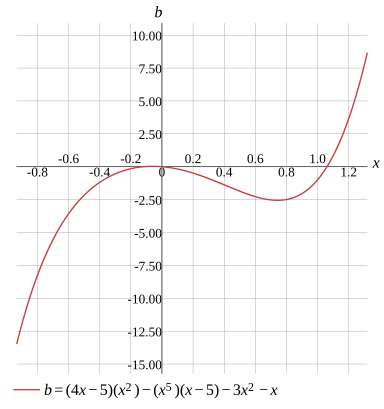Question
Function
Evaluate the derivative
Find the domain
Find the y-intercept
Load more

b′=12x2−16x−6x5+25x4−1
Evaluate
b=(4x−5)x2−x5(x−5)−3x2−x
Simplify
More Steps


Evaluate
(4x−5)x2−x5(x−5)−3x2−x
Multiply the terms
x2(4x−5)−x5(x−5)−3x2−x
Expand the expression
More Steps


Calculate
x2(4x−5)
Apply the distributive property
x2×4x−x2×5
Multiply the terms
4x3−x2×5
Use the commutative property to reorder the terms
4x3−5x2
4x3−5x2−x5(x−5)−3x2−x
Expand the expression
More Steps


Calculate
−x5(x−5)
Apply the distributive property
−x5×x−(−x5×5)
Multiply the terms
−x6−(−x5×5)
Use the commutative property to reorder the terms
−x6−(−5x5)
If a negative sign or a subtraction symbol appears outside parentheses, remove the parentheses and change the sign of every term within the parentheses
−x6+5x5
4x3−5x2−x6+5x5−3x2−x
Subtract the terms
More Steps


Evaluate
−5x2−3x2
Collect like terms by calculating the sum or difference of their coefficients
(−5−3)x2
Subtract the numbers
−8x2
4x3−8x2−x6+5x5−x
b=4x3−8x2−x6+5x5−x
Take the derivative of both sides
b′=dxd(4x3−8x2−x6+5x5−x)
Use differentiation rule dxd(f(x)±g(x))=dxd(f(x))±dxd(g(x))
b′=dxd(4x3)−dxd(8x2)−dxd(x6)+dxd(5x5)−dxd(x)
Calculate
More Steps


Calculate
dxd(4x3)
Use differentiation rule dxd(cf(x))=c×dxd(f(x))
4×dxd(x3)
Use dxdxn=nxn−1 to find derivative
4×3x2
Multiply the terms
12x2
b′=12x2−dxd(8x2)−dxd(x6)+dxd(5x5)−dxd(x)
Calculate
More Steps


Calculate
dxd(8x2)
Use differentiation rule dxd(cf(x))=c×dxd(f(x))
8×dxd(x2)
Use dxdxn=nxn−1 to find derivative
8×2x
Multiply the terms
16x
b′=12x2−16x−dxd(x6)+dxd(5x5)−dxd(x)
Use dxdxn=nxn−1 to find derivative
b′=12x2−16x−6x5+dxd(5x5)−dxd(x)
Calculate
More Steps


Calculate
dxd(5x5)
Use differentiation rule dxd(cf(x))=c×dxd(f(x))
5×dxd(x5)
Use dxdxn=nxn−1 to find derivative
5×5x4
Multiply the terms
25x4
b′=12x2−16x−6x5+25x4−dxd(x)
Solution
b′=12x2−16x−6x5+25x4−1
Show Solution

Solve the equation
b=4x3−8x2−x6+5x5−x
Evaluate
b=(4x−5)x2−x5(x−5)−3x2−x
Solution
More Steps


Evaluate
(4x−5)x2−x5(x−5)−3x2−x
Multiply the terms
x2(4x−5)−x5(x−5)−3x2−x
Expand the expression
More Steps


Calculate
x2(4x−5)
Apply the distributive property
x2×4x−x2×5
Multiply the terms
4x3−x2×5
Use the commutative property to reorder the terms
4x3−5x2
4x3−5x2−x5(x−5)−3x2−x
Expand the expression
More Steps


Calculate
−x5(x−5)
Apply the distributive property
−x5×x−(−x5×5)
Multiply the terms
−x6−(−x5×5)
Use the commutative property to reorder the terms
−x6−(−5x5)
If a negative sign or a subtraction symbol appears outside parentheses, remove the parentheses and change the sign of every term within the parentheses
−x6+5x5
4x3−5x2−x6+5x5−3x2−x
Subtract the terms
More Steps


Evaluate
−5x2−3x2
Collect like terms by calculating the sum or difference of their coefficients
(−5−3)x2
Subtract the numbers
−8x2
4x3−8x2−x6+5x5−x
b=4x3−8x2−x6+5x5−x
Show Solution

Graph
